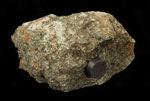Pyroxenite - Mineral and Healing Properties


Chemistry: XY(Si, Al)2O6
Class: Pyroxene
Uses: Blast furnaces as a flux
CLICK HERE To Purchase Kidz Rocks Pyroxenite Products.
-
 Pyroxenite
Pyroxenite
Pyroxenite belongs to the ultramafic group, meaning that it consists almost entirely of dark minerals rich in iron and magnesium. Specifically, its silicate minerals are mostly pyroxenes rather than the other mafic minerals, olivine and amphibole. In the field, pyroxene crystals display a stubby shape and square cross-section whereas amphiboles have a lozenge-shaped cross-section.
They are essentially of igneous origin, though some pyroxenites are included in the metamorphic Lewisian complex of Scotland. The pyroxene-rich rocks which result from the contact metamorphism of impure limestones are described as pyroxene hornfelses (calc-silicate hornfelses).
The igneous pyroxenites are closely allied to the gabbros and norites, from which they differ by the absence of feldspar, and to the peridotites, which are distinguished from them by containing more than 40% olivine. This connection is indicated also by their mode of occurrence, for they usually accompany masses of gabbro and peridotite and seldom are found by themselves.

Origin Of The Name
The name pyroxene comes from the Greek words for fire and stranger in a false allusion. Pyroxenes were named this way because of their presence in volcanic lavas, where they are sometimes seen as crystals embedded in volcanic glass; it was assumed they were impurities in the glass, hence the name "fire strangers". However, they are simply early-forming minerals that crystallized before the lava erupted.

Interesting Facts
Moon rocks contain pyroxenite. A magnet will adhere to pyroxenite due to the minerals it may contain such as iron or chromium.

Where Is It Found
Pyroxenite is a type of intrusive igneous rock that is predominantly composed of pyroxenes. Relatively rare, when pyroxenite does occur it is typically found in dark-colored layers, sheets, veins, narrow dikes, and similar discrete forms. Some of the more notable occurrences of pyroxenite are located in Canada, Ireland, South Africa, and the Pyrenees mountain range.

What Do We Do With It
Pyroxenite is used as a flux in sintering and also in iron and steel industry. The magnesium silicates do not call for calcination (unlike the carbonates) and thus lowers energy requirement in the blast furnace.

Metaphysical Uses
Kidz Rocks pyroxenite contains high concentration of maganetite. Magnetite has powerful positive-negative polarity. It attracts and repels, energises and sedates. It acts as a grounding stone. Magnetite temporarily aligns the chakras, the subtle and etheric bodies. It aids telepathy, meditation and visualisation. Magnetite provides stability, balancing the intellect with the emotions. It brings a balanced perspective and trust in your own intuition. Magnetite attracts love, commitment and loyalty. It alleviates negativity such as fear, anger and grief. Brings positive qualities such as tenacity and endurance.
Magnetite is anti-inflammatory, relieves muscle aches and pains, and is beneficial for asthma, blood and the circulatory system, skin, and hair. It stimulates sluggish organs and sedates overactive ones. Magnetite provides healing energy necessary for recovery.

Physical Characteristics
Color: Dark green to black.
Luster: Dull
Transparency: None
Crystal System: Orthorhombic and monoclinic.
Crystal Habits: Stubby prismatic.
Cleavage: Perpendicular
Hardness: 5 to 7
Specific Gravity: 3 to 4
Streak: Black
Associated Minerals: Olivine and calcium-rich plagioclase and in high-grade metamorphic rocks such as granulites and eclogites.
Best Field Indicators: Magnet adheres to it.




